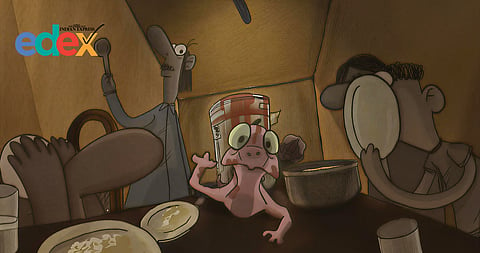

At a time when AI is rapidly remaking the creative landscape, even reimagining mythological epics through algorithms, Rachel Tom Antony, a Communication Design student at IIAD, Delhi, has chosen to look inward. Her 14-minute animated short, Kannimanga, recently won Best Student Film (2D Short Film) at the ASIFA India Awards of Excellence, one of the country’s most respected animation honours. Every frame of the film is hand-drawn, crafted slowly, deliberately, and entirely without AI.
Rachel grew up in the UAE, but her emotional roots lie in Kerala, where her family returned each year to visit her grandparents. Her grandfather passed away when she was just a year old; her grandmother, meanwhile, remained a distant, enigmatic presence. Family gatherings buzzed with chatter, yet Rachel recalls always finding her grandmother tucked away in a corner, reading or writing in her journals. That physical closeness but emotional distance would later become the heart of Kannimanga.
Family memories
Some of Rachel’s earliest memories are of her grandmother preparing Kannimanga, small baby mangoes pickled with care. Because her grandmother struggled to walk, Rachel would gather the mangoes and hand them to her, helping with the ritual she considered an art form. The smell of brine, the quiet afternoons, the green Kerala courtyard; these became the foundation of her most enduring memories.
That sense of gentle disconnect of loving someone without truly knowing them became the emotional engine of the film. When Rachel later learned that many of her grandmother’s journals had been burned, the urge to create a record of her own became urgent. The film, she says, is both a search for what was lost and an imagined alternate reality where she could have known her grandmother more intimately.
Most of the film unfolds within the family home. Rachel pored over old photographs to recreate its textures, shadows and emotional mood. Guided by her mentor, Shaaz Ahmed, she began with a chronological timeline, then stripped away everything that didn’t serve the story’s core. She eventually drew a detailed storyboard, building the film frame by frame.
A handmade film
The visuals came together in muted palettes, layered textures inspired by Kerala’s lush landscape, paired with a journal-style voiceover that echoes her grandmother’s writing. The drawing, pre-production and post-production took two and a half months, with Rachel crafting much of the film in Kerala, her grandmother still physically by her side.
“It’s a handmade film. Every line, every movement carries my hesitation and hope,” she says. The choice to keep the film entirely analogue was intentional -- an act of resistance to a moment in which AI tools increasingly flatten artistic labour. For Rachel, the ASIFA recognition affirmed not just her craft, but her belief in a slower, more meditative storytelling process.
But it wasn’t always easy. Despite her design background, animation was a new territory. “It had more storytelling involved,” she explains. “Structuring was very important. But once I understood the process, things became easier.”
Interviewing other families during her research, Rachel found that many shared similar relationships with their elders; filled with love, yet marked by distance. That helped her view her own grandmother with new empathy. “Everyone has their own story,” she says. “A little empathy and receptiveness can make a world of difference.”
A kind of closure
What changed between them after the film? Surprisingly, not much. The quiet distance remains. Yet making the film offered Rachel a kind of closure—not by changing the relationship, but by understanding it. The house, the mangoes, the journals: these became her language of connection.
Rachel admits she was initially unsure about pursuing animation in an era ruled by technology. But the warm reception for Kannimanga reinforced her faith in storytelling. “People will always love stories,” she says. “The art of weaving a narrative will never die. How you choose to tell it is what matters.”
In Kannimanga, that choice meant returning to the simplest tools – memory, pencil, and patience – to honour a grandmother who spoke most loudly in silence.
(By Keerthivas of The New Indian Express)
